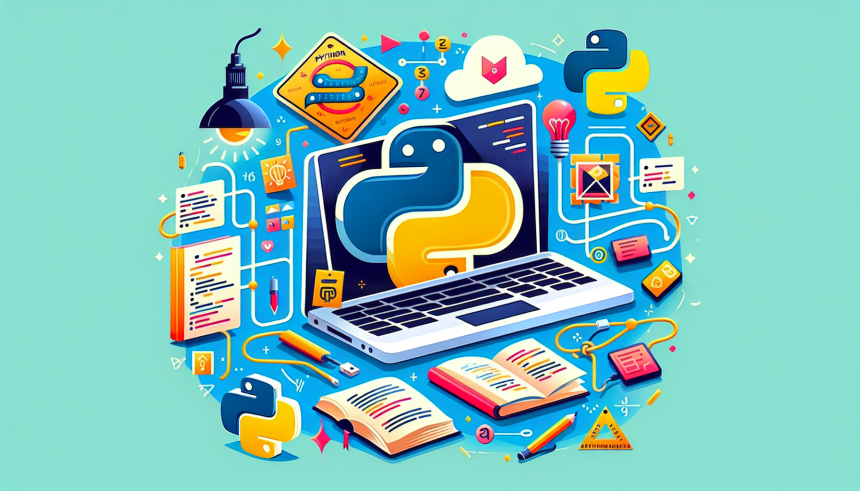What is Python?
Python is a high-level, interpreted programming language known for its readability and simplicity. Designed by Guido van Rossum and released in 1991, Python emphasizes code readability through its clear syntax. It is versatile and can be used for a variety of applications, ranging from web development and data analysis to artificial intelligence and scientific computing.
Why Learn Python?
-
Beginner-Friendly: Python’s syntax closely resembles English, making it easier for newcomers to grasp programming concepts.
-
Huge Community Support: Python boasts an extensive community, providing numerous tutorials, forums, and libraries to assist programmers.
-
Wide Range of Applications: From web development using frameworks like Django to data science with libraries like Pandas, Python’s applications are diverse.
-
Highly Portable: Python can run on various operating systems like Windows, macOS, and Linux without modifications.
Setting Up Your Environment
Installing Python
-
Download Python: Visit python.org and download the latest version suitable for your operating system.
-
Installation: On Windows, ensure you check the box that says “Add Python to PATH” during installation. For macOS, you can also use Homebrew with the command:
brew install python -
Verify Installation: Open your terminal or command prompt and type:
python --versionThis should display the installed version of Python.
Setting Up an Integrated Development Environment (IDE)
-
Choosing an IDE: Install an IDE like PyCharm, Visual Studio Code, or Jupyter Notebook, which are beginner-friendly and feature rich.
-
Configuration: Follow setup instructions specific to your chosen IDE to create a Python project.
Writing Your First Python Program
-
Open your IDE: Create a new Python file, for example,
hello.py. -
Write Code:
print("Hello, World!") -
Run the Program: If using a terminal, navigate to the directory containing your file and execute:
python hello.pyYou should see the output:
Hello, World!
Python Basics: Data Types
Understanding Python’s fundamental data types is essential for any programmer.
-
Numbers: Include integers (e.g.,
5,42) and floats (e.g.,3.14,2.5). -
Strings: Text data is enclosed in single (
') or double quotes ("). For example:greeting = "Hello" -
Booleans: Represent truth values with
TrueorFalse. -
Lists: Ordered collections of items:
colors = ["red", "green", "blue"] -
Dictionaries: Key-value pairs that are unordered:
person = {"name": "Alice", "age": 25}
Control Structures
Conditional Statements
Conditional statements allow the execution of code blocks based on certain conditions.
age = 20
if age >= 18:
print("You are an adult.")
else:
print("You are a minor.")Loops
Loops, such as for and while, enable repetitive execution of code blocks.
For Loop Example:
for color in colors:
print(color)While Loop Example:
count = 0
while count < 5:
print(count)
count += 1Functions
Functions are reusable blocks of code that perform specific tasks. They are defined using the def keyword:
def greet(name):
return f"Hello, {name}"
print(greet("Alice"))Error Handling
Python uses try-except blocks to manage errors gracefully.
try:
result = 10 / 0
except ZeroDivisionError:
print("Cannot divide by zero.")Libraries and Frameworks
Python has a rich ecosystem of libraries and frameworks to simplify programming tasks.
- NumPy: Essential for numerical calculations.
- Pandas: Perfect for data manipulation and analysis.
- Matplotlib: Useful for plotting and data visualization.
- Django: A robust web framework for building web applications.
Learning Resources
-
Official Documentation: The Python documentation is comprehensive and contains many tutorials.
-
Online Courses: Platforms like Coursera, Udemy, and edX offer structured Python courses.
-
YouTube Tutorials: Channels like Corey Schafer and Programming with Mosh provide free video tutorials.
-
Books: Titles like “Automate the Boring Stuff with Python” by Al Sweigart are great for beginners.
Best Practices
-
Readability: Write clean and readable code. Use meaningful variable names and consistent indentation.
-
Commenting: Use comments to explain complex logic.
# This function calculates area def area(radius): return 3.14 * radius * radius -
Version Control: Use tools like Git to manage your projects and collaborate with others.
Final Tips for Python Beginners
- Start Small: Begin with manageable projects, like building a calculator or a simple game.
- Practice Regularly: Consistency is key to reinforcing what you learn.
- Engage with Community: Participate in forums (e.g., Stack Overflow) and local meetups to enhance learning.
Conclusion: Take the Next Step
This guide is a primer for your Python journey. Embrace mistakes as part of the learning process, and don’t hesitate to explore new areas within Python. Happy coding!


